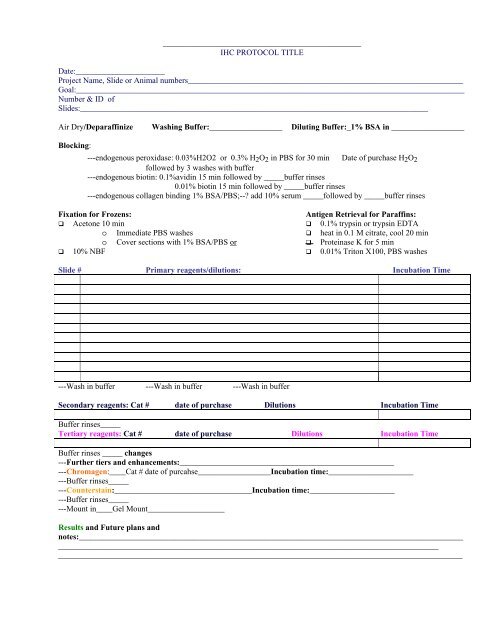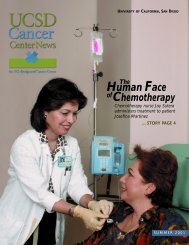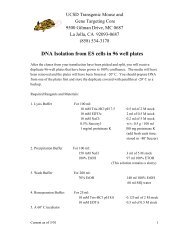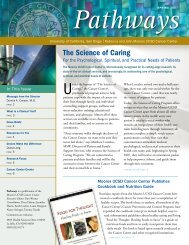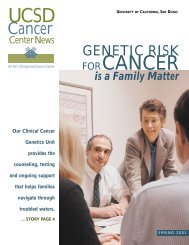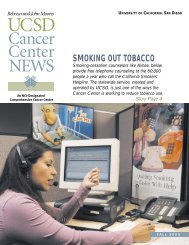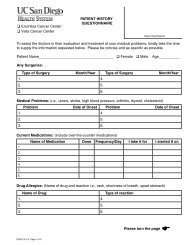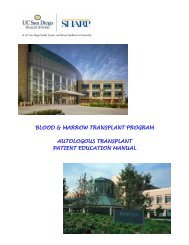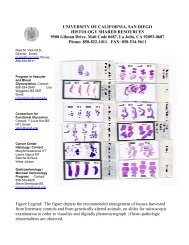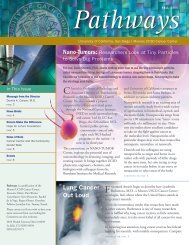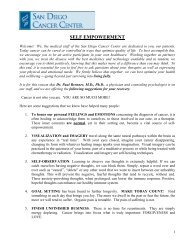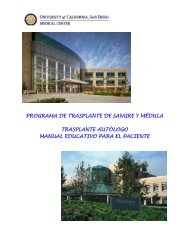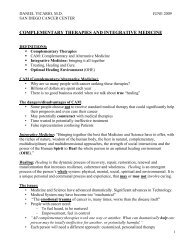Create successful ePaper yourself
Turn your PDF publications into a flip-book with our unique Google optimized e-Paper software.
_________________________________________________<br />
<strong>IHC</strong> PROTOCOL TITLE<br />
Date:______________________<br />
Project Name, Slide or Animal numbers____________________________________________________________________<br />
Goal:________________________________________________________________________________________________<br />
Number & ID of<br />
Slides:______________________________________________________________________________________<br />
Air Dry/Deparaffinize Washing Buffer:__________________ Diluting Buffer:_1% BSA in __________________<br />
Blocking:<br />
---endogenous peroxidase: 0.03%H2O2 or 0.3% H 2 O 2 in PBS for 30 min Date of purchase H 2 O 2<br />
followed by 3 washes with buffer<br />
---endogenous biotin: 0.1%avidin 15 min followed by _____buffer rinses<br />
0.01% biotin 15 min followed by _____buffer rinses<br />
---endogenous collagen binding 1% BSA/PBS;-- add 10% serum _____followed by _____buffer rinses<br />
Fixation for Frozens:<br />
Acetone 10 min<br />
o Immediate PBS washes<br />
o Cover sections with 1% BSA/PBS or<br />
10% NBF<br />
Antigen Retrieval for Paraffins:<br />
0.1% trypsin or trypsin EDTA<br />
heat in 0.1 M citrate, cool 20 min<br />
Proteinase K for 5 min<br />
0.01% Triton X100, PBS washes<br />
Slide # Primary reagents/dilutions: Incubation Time<br />
---Wash in buffer ---Wash in buffer ---Wash in buffer<br />
Secondary reagents: Cat # date of purchase Dilutions Incubation Time<br />
Buffer rinses_____<br />
Tertiary reagents: Cat # date of purchase Dilutions Incubation Time<br />
Buffer rinses _____ changes<br />
---Further tiers and enhancements:_____________________________________________________<br />
---Chromagen:____Cat # date of purcahse__________________Incubation time:_____________________<br />
---Buffer rinses_____<br />
---Counterstain:__________________________________Incubation time:_____________________<br />
---Buffer rinses_____<br />
---Mount in____Gel Mount___________________<br />
Results and Future plans and<br />
notes:_______________________________________________________________________________________________<br />
______________________________________________________________________________________________<br />
____________________________________________________________________________________________________
<strong>Protocol</strong> for immunohistochemical staining of Paraffin sections to unmask<br />
epitopes (AR) with amplification, using catalyzed signal amplification<br />
A. Tissue Controls:<br />
1. Positive control: Cells or tissue expected to be positive. Positive controls may also be the<br />
cells that are know to express the epitope, that are grown in tissue culture up to about 100<br />
million, taken and made into a pellet, fixed, paraffin embedded and sectioned.<br />
2. Negative control: Cells or tissue expected to be negative.<br />
3. Blocking peptide (see below)<br />
B. Reagent controls:<br />
1. 1% BSA/PBS reagent negative control for secondary reagents<br />
2. Rabbit IgG Dako Cat.# 1505 Negative control reagent at 5 ug/ml<br />
3. Rabbit anti human vWf Dako Cat# 0936 (pre-diluted). Positive for blood vessels in tissue.<br />
4. Mouse anti Vimentin Dako Catalog# N1521 prediluted, ready to use, as a technical positive<br />
control when using mouse antibodies as test<br />
5. Mouse IgG at 5 ug/ml<br />
6. Further controls included staining of cells expressing higher levels of epitope in question, and<br />
using the immunizing peptide (1 mg/ml) at a 1:50 dilution to compete out the reactivity of the<br />
antibody, resulting in a negative stain.<br />
C. Deparaffinization:<br />
----Label slides with date and reagent to be applied and take to the fume hood where the<br />
deparaffinization will occur<br />
-----BMRUAD= briefly move rack up and down. Move slide holder up and down so that the slides get<br />
“washed” before leaving the slide rack in the dish for the specified amount of time.<br />
1. Dip into Xylene (in green tub in the fume hood) ---BMRUAD and then leave for 10 minutes, and<br />
repeat two more times<br />
2. Dip into 100% alcohol, BMRUAD and then leave for 5 minutes, and repeat one more time<br />
3. Dip into 95% alcohol, BMRUAD and then leave for 5 minutes, and repeat one more time<br />
4. Dip into 70% alcohol, BMRUAD and then leave for 5 minutes, and repeat one more time<br />
5. Dip into TBST buffer, BMRUAD and then leave for 5 minutes, and repeat two more times<br />
TBST= Tris buffered saline with 0.05% Tween 20<br />
May also use PBS pH 7.1 but TBST helps to disperse the reagent evenly over entire section<br />
D. Antigen Retrieval AR (should use the steamer because the microwave method is patented)<br />
1. fill green tub with AR buffer of choice<br />
2. fill slide holder with “dummy” slides and intersperse the test slides among the dummy slides<br />
so that the slide holder is full of slides—this allows even heating<br />
3. cover and place in larger container with water that goes halfway up the tub, and heat for 5<br />
minutes on high.<br />
4. check levels and repeat a second time, for 5 more minutes<br />
5. remove slide container from microwave, (Careful—IT WILL BE HOT) remove lid and let the<br />
container sit on bench top for 20 minutes, to cool<br />
6. Dip into TBST buffer, BMRUAD and then leave for 5 minutes, Repeat two more times<br />
E. Block ENDOGENOUS PEROXIDASES . Immerse slides in slide holder in 0.3% H 2 O 2 in PBS for<br />
30 minutes at room temperature, followed with 3 buffer washes
F. Block ENDOGENOUS BIOTIN<br />
1. Overlay with 0.1% avidin for 10 – 15 minutes (following manufacturer’s suggestions),<br />
followed by 3 buffer washes<br />
2. Overlay with 0.01% biotin for 10 – 15 minutes (following manufacturer’s suggestions),<br />
followed by 3 buffer washes<br />
G. IMMUNOSTAINING:<br />
1. Overlay sections with CSA kit blocking solution to block non-specific protein binding<br />
2. Overlay sections with Reagents 1 (Primary antibody used at predetermined dilution) or negative<br />
reagent controls) and incubate in humidified chamber for the specified length of time. Do not let<br />
the sections dry out at any time or this will contribute to high background.<br />
Follow Kit instructions<br />
N.B. Buffer has to have an increased concentration of salt, please refer to kit instructions.<br />
MATERIALS:<br />
1. BSA—Sigma Cat. No. A2153<br />
2. CSA Kit—DAKO Cat. No. K1500<br />
3. or if you prefer fluorescence, TSA kit from NEN<br />
4. green staining dish (VWR Cat.# 25608-904)<br />
5. white staining dish VWR Cat.# 25608-906<br />
6. slide holder (VWR Cat# 25608-868)<br />
7. PBS buffer phosphate buffered saline pH 7.4<br />
8. TBS buffer : a. Biogenex Cat. # HK098-5K<br />
b. DAKO Cat.# S1968<br />
9. Tween 20 (Polyoxyethylene-Sorbitan Monolaureate)—Sigma Cat. No. P1379<br />
10. Commercially available Antigen retrieval buffer from Biogenex or from Dako<br />
11. OR Prepare 0.01 M Citrate Buffer, pH 6.0 (41 mL 0.1 M Sodium Citrate, 9 mL 0.1 M Citric<br />
Acid + 450 mL MQ Water) in 350 W Microwave – 5 min, twice see procedure outlined above<br />
12. Avidin/Biotin Blocking Kits: a. Vector Cat. No. SP-2001<br />
b. Dako Cat. No. X0590<br />
c. Sigma Avidin Cat no A 9275<br />
d. Sigma Biotin Cat no B4501<br />
13. Mouse Anti Human Vimentin—DAKO Cat. No. N1521 prediluted<br />
14. Mouse IgG monoclonal supernatant from P3X63 Ag8, usually at 5 ug/ml, negative reagent<br />
control<br />
15. Rabbit anti human vWf Dako Cat # N1505<br />
16. Rabbit IgG Dako Cat.# X0936 negative rabbit reagent control, use at 5 ug/ml<br />
17. AEC substrate: a. Vector Cat. No. SK-4200<br />
b. Biogenex Cat # HK092-5K<br />
18. 30% H 2 O 2 —Fisher Cat. No. H325-100<br />
19. Aquamount—Fisher Cat. No. BM-01<br />
20. Mayer’s Hematoxylin— Sigma Cat. No. MH532-1L


